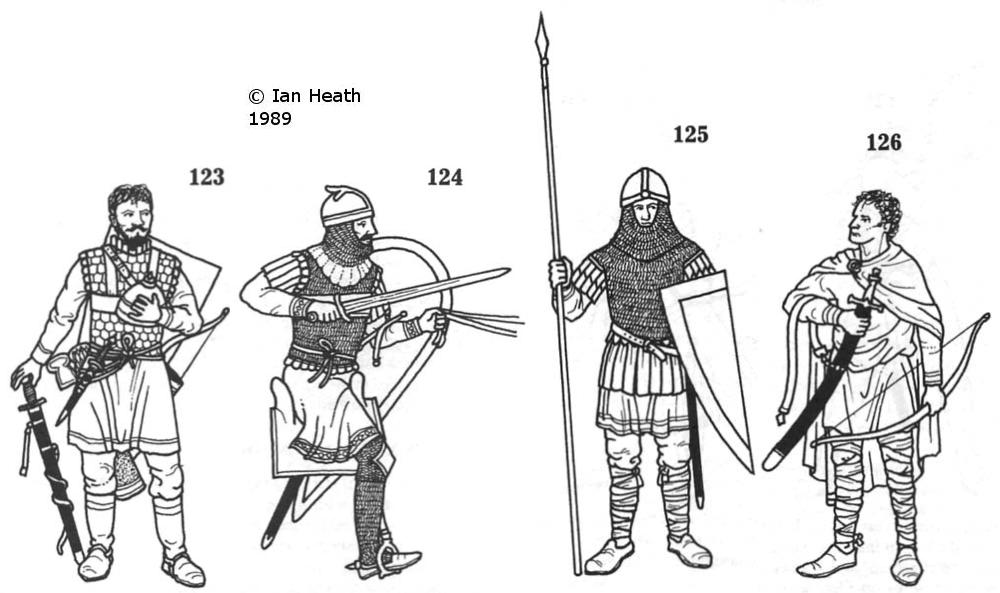SERBIAN SOLDIERS, 12th-13th CENTURIES
An extract from Armies of Feudal Europe 1066-1300by Ian Heath
 | |||
| [Based on a Fresco in Dečani church, Monastery St. Theodore Tiro, Visoki Dečani, Serbia.] |
|||
 | |||
| [Based on a Fresco in Dečani church, Monastery St. Theodore Tiro, Visoki Dečani, Serbia.] |
|||
123, 124, 125 & 126. SERBIAN SOLDIERS, 12th-13th CENTURIES
Bearing in mind that Serbia was part of the Byzantine Empire until the last quarter of the 12th century, and even thereafter remained culturally within the Byzantine sphere of influence, it is hardly surprising to find that Serbian soldiers as depicted in 12th-14th century frescoes and mss. are virtually indistinguishable from those of Byzantium, a state of affairs which only began to change as Western European influence exerted itself (via Hungary) in the course of the 13th-14th centuries. Even then, Byzantine-style equipment remained in use alongside the more characteristic Western panoply that was introduced, being especially evident in the retention of the recurved bow and traditional types of shield, sword (specifically the korda, a single-edged weapon with a slightly curved blade and a hilt shaped in the form of a bird's head), knife and other weapons (eg, the kijacek, a wooden maul similar to those later used by English archers). In fact the 4 figures depicted here — 2 foot-soldiers and 2 oklopniki (heavy cavalrymen) — show little evidence of Western influence, with the single exception of 124’s poleyns fitted to his mail chausses. Their pteruge-edged, hip-length corselets are characteristically Byzantine, right down to the reinforcing leather breast- and shoulder-bands of 123 and 124. Some idea of the defensive capabilities of such armour can be assessed from an episode recorded by Cinnamus, where during a battle in 1150 a Byzantine cataphract was unable to drive his lance through a Serbian zupan's back because of the strength of the latter’s corselet.
The use of the bow by Serbian horsemen requires some further comment. That Serbian cavalry did indeed use the bow is confirmed by 13th-14th century sources: the Serbians in the Nicaean Byzantine army at Pelagonia in 1259 are described as horse-archers, and horse-archery is referred to in addition at the Battle of Velbuzhd in 1330 and elsewhere by Cantacuzene. In addition some Serbian ms. illustrations also depict men firing their bows from horseback. However, it must be emphasised that the bow was regarded as a secondary weapon by Serbian horsemen, who, significantly, were regarded by their contemporaries as skilled lancers: Serbians in the Byzantine army at Semlin in 1167 are described by Cinnamus as having just ‘spears and broad shields’, and his account of Emperor Manuel's fight against the Serbians on the Tara in 1150 refers only to the use of swords and lances by their cavalry. Despite their shape Serbian bows were not composite, being made chiefly of yew with horn nocks. They had an effective range of up to 165-220 yards.
Infantry were chiefly either armoured spearmen provided by the voynuks or unarmoured archers provided by the vlastela’s servants, of whom figures 125 and 126 respectively, dating to c.1235 and the mid-13th century, are characteristic. Other popular weapons were the mace (particularly amongst horsemen) and the axe, which assumed a variety of forms, most of them bearded and many also narrow-bladed like that of figure 109. The crossbow, though not unknown, only became widespread under Western influence in the 14th century, and even then was heavily outnumbered by the bow.